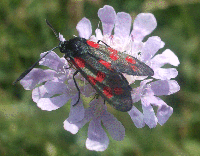When to Watch Wildlife |
J | F | M | A | M | J | J | A | S | O | N | D | Search |
|
Current wildlife highlights |
||
|
What's new on this site |
||
|
Wildlife calendar |
||
|
Plants and Animals |
||
|
Habitats |
||
|
Wildlife sites |
||
|
WWW links |
||
|
Guide Books |
||
|
||
|
© PMcS 2006 |
Insects |
|
|
|
Insects are hugely important to our own survival. Bees for example
play a critical role in pollinating many of our food plants, such as fruit
trees. They are varied and fascinating. Some are loved (butterflies
and lady birds) and some are not (earwigs, fleas, aphids and midges) - all
are fascinating if you look closely enough! If you try and name
insects you may well surprise yourself with how many you know.
Insects always have 6 legs. three body sections (head, thorax, where the legs are, and abdomen) and they often have wings. Usually the young look like small versions of the adults. However in some cases, such as butterflies and blue bottles, the young stages are different (i.e. caterpillars and maggots). There are more than 20,000 species in Britain. Below are some of the 'creepy crawlies' you are most likely to come across - you see and you thought that you did not know many insects!
Other small beasties (non insects)
|
All images and text are copyright PMcS 2006
